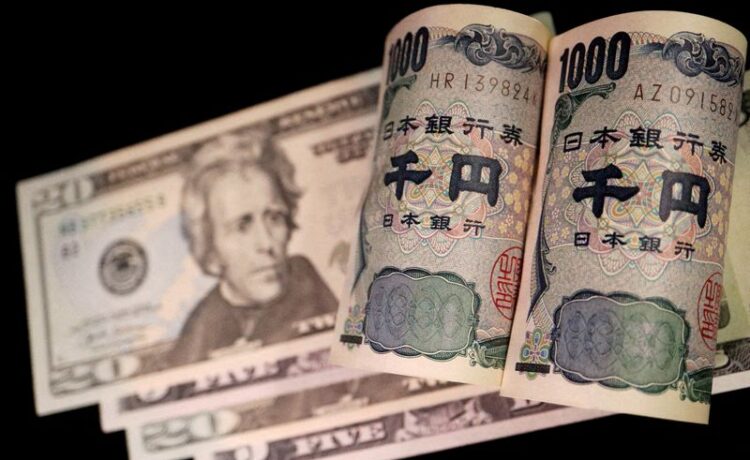By Rae Wee, Vidya Ranganathan
(Reuters) -The yen jumped suddenly against the dollar on Monday, with traders citing yen-buying intervention by Japanese authorities to try to underpin a currency languishing at levels last seen over three decades ago.
The dollar fell sharply to a low of 154.40 yen from as high as 160.245 earlier in the day. Banking sources said Japanese banks were seen selling dollars for yen. It was last trading at 155.83 yen.
Traders had been on edge for weeks for any signs of action from Tokyo to prop up a currency that has fallen 11% against the dollar so far this year. The yen plunged to 34-year lows even though the central bank exited from negative interest rates in a historic move last month.
Currency traders have bet that despite the change, Japanese rates will remain low for some time in contrast to relatively high U.S. interest rates.
Japan’s top currency diplomat Masato Kanda declined to comment when asked if authorities had intervened, but said the current developments in the currency market were “speculative, rapid and abnormal” and could not be overlooked.
Japan’s Ministry of Finance (MOF) was not immediately available for comment, with markets in the country closed for a holiday on Monday.
“Today’s move, if it represents intervention by the authorities, is unlikely to be a one-and-done move,” said Nicholas Chia, Asia macro strategist at Standard Chartered Bank in Singapore.
“We can likely expect more follow through from MOF if the dollar/yen pair travels to 160 again. In a sense, the 160-level represents the pain threshold, or new line in the sand for the authorities.”
A weaker yen is a boon for Japanese exporters, but a headache for policymakers as it increases import costs, adds to inflationary pressures and squeezes households.
Bank of Japan Governor Kazuo Ueda told a press conference after a meeting last week that monetary policy does not directly target currency rates, although exchange-rate volatility could have a significant economic impact.
The yen had moved nearly 3.5 yen between 158.445 and 154.97 on Friday as traders vented their disappointment after the Bank of Japan kept policy settings unchanged and offered few clues on reducing its Japanese government bond (JGB) purchases – a move that might help put a floor under the yen.
The yen has been under pressure as U.S. interest rates have climbed and Japan’s have stayed near zero, driving cash out of yen and into higher-yielding assets.
The U.S.-Japan government bond yield gap for 10-year tenures is about 375 bps, providing a powerful incentive for yen bears.
“Whether it is in effect intervention, we will only know later,” said Mahjabeen Zaman, head of foreign exchange research at ANZ in Sydney.
“In past interventions, we have seen that the immediate response of the yen is it moves by a few yen but then it trades back in line with fundamentals and I think the biggest driver for dollar/yen is the U.S.-Japanese yield differentials.”
LIMITED OPTIONS
The BOJ is not mandated to manage the currency but a weak yen complicates its objective of achieving sustainable inflation. It can’t raise rates quickly either, for fear of destabilising Japan’s heavily indebted government and economy.
Government bonds offer yields far below foreign sovereigns, which draw a constant flow of Japanese money abroad, weighing on the yen.
The suspected intervention happened days ahead of the Federal Reserve’s policy review on May 1. Expectations for Fed rates cuts have been pushed back all year as U.S. inflation remained elevated. Policymakers, including Fed Chair Jerome Powell, have emphasised rate changes will be dependent on data.
That could mean intervention alone isn’t effective in putting a floor under the yen.
“A combination of BOJ demonstrating urgency to normalise policy and MOF conducting FX intervention may perhaps be more effective than the MOF doing a solo,” said Christopher Wong, currency strategist at OCBC in Singapore.
Japan intervened in the currency market three times in 2022, selling the dollar to buy yen, first in September and again in October as the yen slid towards 152 to the dollar, a 32-year low at the time. Tokyo is estimated to have spent around $60 billion defending the currency at that time.
The United States, Japan and South Korea agreed earlier this month to “consult closely” on currency markets in a rare warning and Tokyo has stepped by its rhetoric against excessive yen moves.
On Monday, the European Central Bank declined to comment on the action in the currency market.
The yen has also hit multi-year lows against the euro, Australian dollar and Chinese yuan.
(Reporting by the Reuters Markets Team; Additional reporting by Ankur Banerjee, Stella Qiu, Tom Westbrook, Takaya Yamaguchi and Leika Kihara; Writing by Vidya Ranganathan and Shri Navaratnam; Graphics by Pasit Kongkunakornkul; Editing by Neil Fullick and Christina Fincher)















